brake light AUDI A3 2012 Owner´s Manual
[x] Cancel search | Manufacturer: AUDI, Model Year: 2012, Model line: A3, Model: AUDI A3 2012Pages: 280, PDF Size: 70.11 MB
Page 96 of 280

94 On the road
Cruise control
Switching the system on
The cruise control system makes it possible to
drive at a constant speed starting at 20 mph (30 km/h) .
Fig. 105 Control lever wi th set button
Fi g. 106 Disp lay: Se lected speed
• Pull t he lever to posi tion (D ¢ fig . 105 to
switch the sys tem on.
• Drive at the speed you wish to set .
• Press b utton @ to set that speed .
The display
¢fig. 106 will show the set s peed .
The display may v ary depending on t he type o f
display in yo ur vehicle. The indicator
light
[ifj11 )~1~ (US mode l) I. (Canadian mode l)
will also light up in the instrument cluster.
A WARNING
- Always pay attention to traffic even when
the cruise control is switched on . You are
always responsible for your speed and
the distance between yo ur vehicle and
othe r vehicles .
- For safety reasons, the c ruise control
sho uld not be used in the city, in stop
and -go traff ic, on twist ing roads an d
when ro ad conditions are poo r (such as ice,
fog, gravel, heavy rain and hydro
plan ing) -risk of accident.
- Turn off the cruise contro l temporarily
when enter ing turn lanes, highway exit
lanes or in construction zones.
- Please note that inadvertently "resting"
your foot on the accelerator pedal causes
the cruise co ntrol not to brake. This is
because the cruise control is over ridden
by the dr ive r's acceleration.
(D Tips
- Veh icles with man ual transmiss ion: You
can attai n the set speed only if the cur
rently engaged gear allows it and the en
gine is not stressed . Sh ifting to a highe r
o r low er gea r promptly will a llow the en
gine to r un smooth ly.
- The cr uise control can not mainta in a
constant speed when driv ing downhi ll.
T he vehi cle w il l accele rate under i ts own
we ight. Dow nshift to a lower ge ar or use
the brakes to slow down .
Changing speed
• Press lever in the 0 or 0 direct io n
¢ page 94, fig. 105 to increase or decrease
your speed.
• Release the lever to save that speed .
Change speed in increments of 1 mph (1 km/
h) by lightly pressing the lever. I f you keep the
lever pressed down, you will alter your speed
in S mph (10 km/h) increments.
You can also press t he accelerator pedal down
to increase your speed, e.g. if you want to
pass someone. The speed you saved earlier
will resume as soon as you release the acceler
ator pedal.
If, however , you exceed yo ur saved speed by
5 mph (10 km/h) for longer than 5 minutes,
the cru ise control will turn off temporari ly.
T he symbo l will go out but the saved speed
will be reta ined .
Page 97 of 280
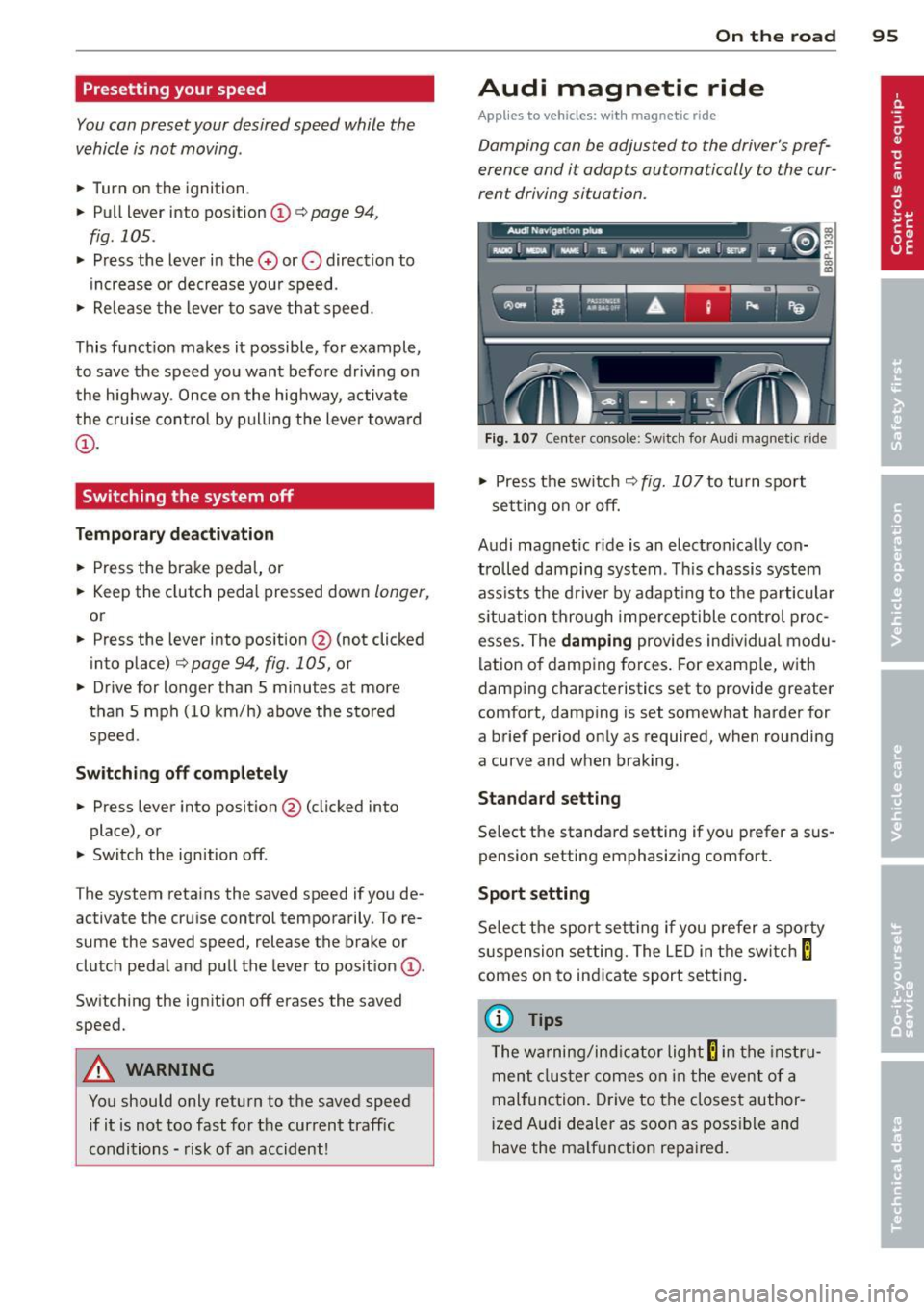
Presetting your speed
You can preset your desired speed while the
vehicle is not moving .
.,. Turn on the ignition.
.,. Pull lever into position ©
c:> page 94,
fig . 105 .
"" Press the lever in the 0 or O direction to
increase or decrease yo ur speed .
.,. Re lease the lever to save that speed.
This function makes it possible, for example,
to save the speed you want before driving on
the highway . Once on the highway, activate
the cruise control by pulling the leve r toward
® ·
Switching the system off
Temporary deactivation
.,. Press the brake pedal, or
.,. Keep the clutch pedal pressed down
longer,
or
.,. Press the lever into pos ition @ (not clicked
into place)
c:> page 94, fig. 105, or
.,. Drive for longer than 5 minutes at more
than 5 mph (10 km/h) above the stored
speed.
Switching off completely
.,. Press lever into position@(clicked into
place), or
.,. Switch the ign ition off .
The system retains the saved speed if you de activate the cruise control temporarily. To re
sume the saved speed, release the brake or
clutch pedal and pull the lever to position
(D.
Switching the ignition off erases the saved
speed.
A WARNING
You should only return to the saved speed
if it is not too fast for the current traffic
conditions -risk of an accident!
On the road 95
Audi magnetic ride
Applies to vehicles: with magnetic ride
Damping can be adjusted to the driver's pref
erence and it adapts automatically to the cur
rent driving situation .
Fig. 107 Center console: Sw itch for Aud i magnet ic ride
.,. Press the switch c:> fig. 10 7 to turn sport
sett ing on or off.
Audi magnet ic r ide is an electronically con
trolled damping system . This chassis system
ass ists the driver by adapting to the particular
s ituat ion through imperceptible control proc
esses. The
damping provides individual modu
lation of damping forces. For example, with
damping characteristics set to provide greater
comfort, damping is set somewhat harder for
a brief period on ly as required, when rounding
a curve and when braking.
Standard setting
Select the standard setting if you prefer a sus
pension setting emphasizing comfort.
Sport setting
Select the sport setting if you prefer a sporty
suspension setting. The L ED in the switch
E
comes on to ind icate sport setting .
(D Tips
The warning/indicator light E in the instr u
ment cluster comes on in the event of a
malfunction. Drive to the closest author
i zed Audi dealer as soon as possible and
have the ma lfunction repa ired.
Page 99 of 280
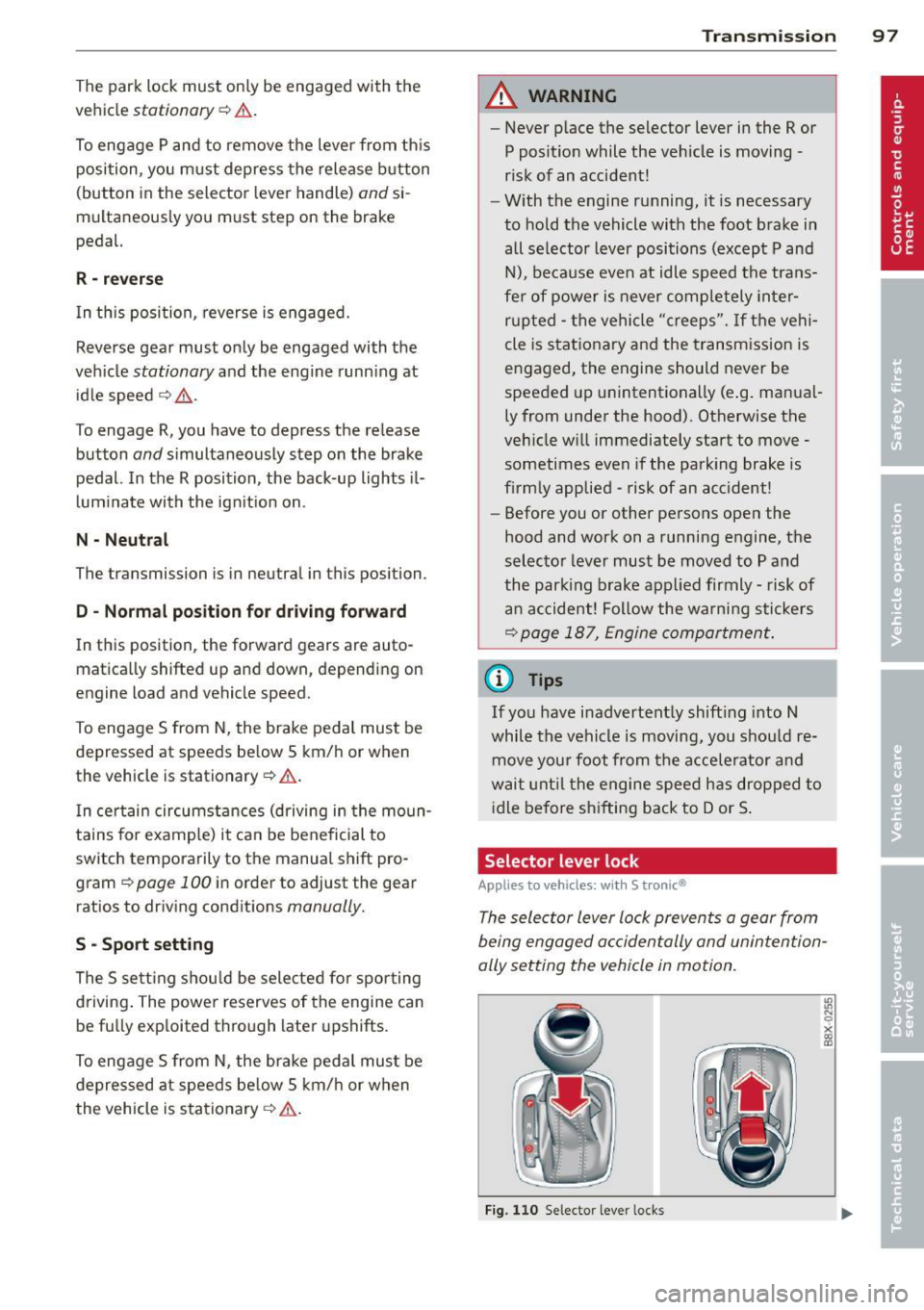
The park lock must only be engaged with the
vehicle
stationary c::> &.
To engage P and to remove the lever from th is
position, you must depress the release b utton
(button in the selector lever handle)
and si
multaneously you must step on the brake
pedal.
R · re vers e
I n th is position, reverse is engaged.
Reverse gear must only be engaged with the
veh icle
stationary and the eng ine runn ing at
id le speed
c::> ,&. .
To engage R, you have to depress the release
button
and s imultaneously step on the brake
pedal. In the R position, the back-up lights il
lum inate with the ign ition on.
N • N eutra l
The transmission is in neutral in this position .
D -Norm al po sition f or d riving forwa rd
In this position, the forward gears are auto matica lly shifted up and down, depending on
engine load and vehicle speed.
To engage S from N, the brake pedal must be
depressed at speeds be low S km/h or when
the vehicle is stationary
c::> & .
In certain circumstances (driving in the moun
tains for examp le) it can be beneficial to
switch temporarily to the manua l shift pro
gram
c::> page 100 in order to adjust the gear
ratios to driving cond itions
manually.
S -Sport setting
The S se tt ing shou ld be selected for sporting
d riving . The power reserves of the engine can
be fu lly exp loited through later upshifts.
To engage S from N, the brake pedal must be depressed at speeds be low S km/h or when
the vehicle is stationary
c::> & .
Tra n sm iss io n 9 7
A WARNING
- Never p lace the selector lever in the R or
P posit ion while the veh icle is moving -
risk of an accident!
- With the engine running, it is necessary
to hold the vehicle with the foot brake in all se lector lever positions (except P and
N), because even at idle speed the trans
fe r of power is never completely inter
rupted -the vehicle "creeps". If the vehi
cle is stationary and the transm ission is
engaged, the engine should never be
speeded up unintentionally (e .g. manual
ly from under the hood). Otherwise the
veh icle w ill immediately start to move -
sometimes even if the park ing brake is
firmly applied -risk of an accident!
- Before you or other persons open the
hood and work on a running engine, the
selecto r lever must be moved to P and
the park ing brake applied f irmly - risk of
an accident! Follow the warning sticke rs
c::> page 187, Engine compartment.
(D Tips
If you have inadvertently shift ing into N
while the vehicle is moving, you shou ld re
move you r foot from the accelerator and
wait unt il the engine speed has dropped to
idle before shifting back to Dor S .
Selector lever lock
Applies to vehicl es: with S tronic®
The selector lever lock prevents a gear from
being engaged accidentally and unintention
ally setting the vehicle in motion.
F ig. 110 Selector lever locks
Page 100 of 280
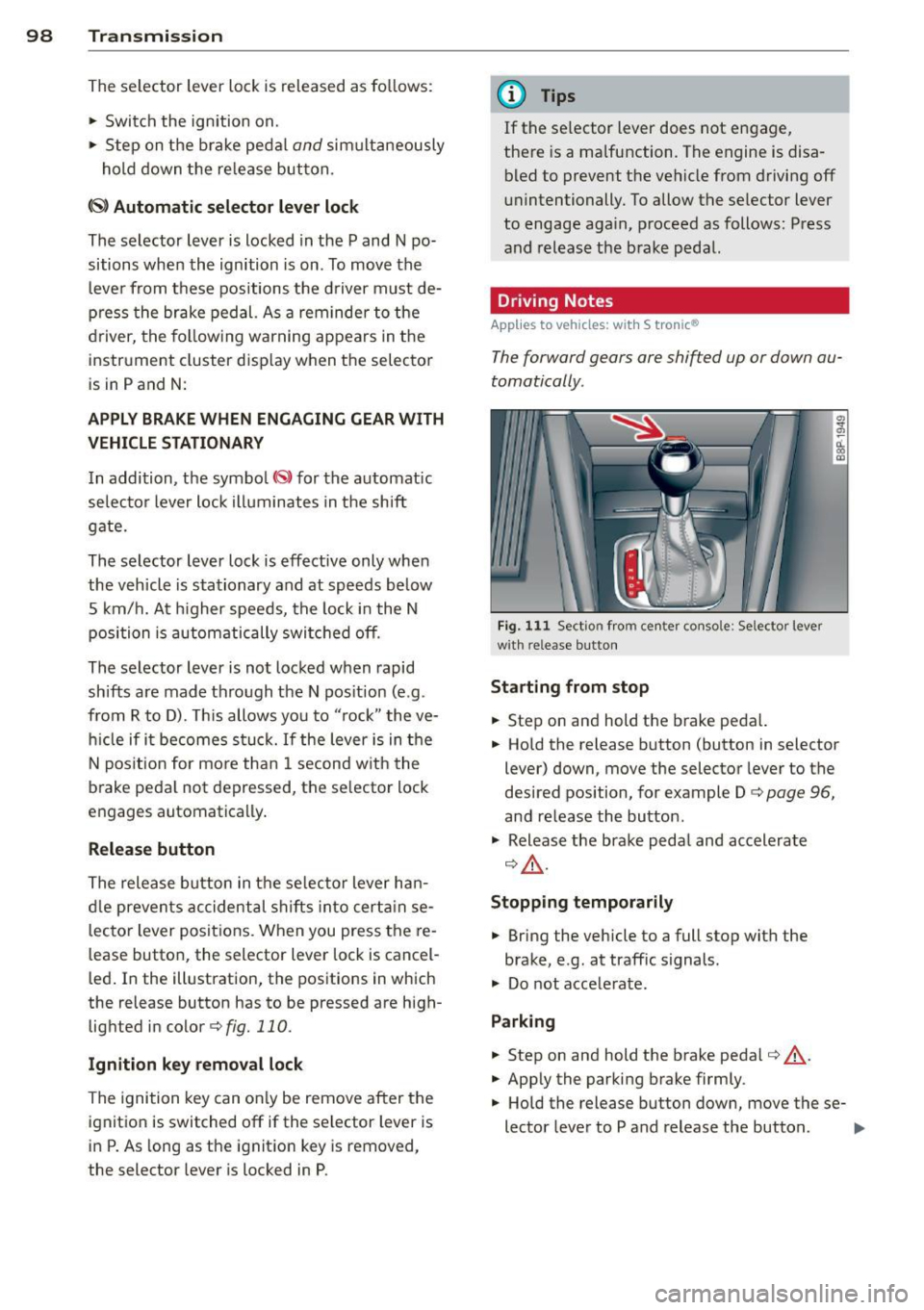
98 Transmission
The selector lever lock is released as fo llows:
,. Switch the ign ition on.
,. Step on the brake peda l
and simult aneously
ho ld down the re le ase but ton .
(~ Automatic selector lev er lock
The selector lever is locked in the P and N po
sitions when the ignition is on . To move the
l eve r from these positions the d river must de
p ress the brake pedal. As a reminde r to the
d river, the fo llow ing warning appea rs in t he
instr ument cluster d isp lay when the selecto r
is in P and N :
APPLY BRAKE WHEN ENGAGING GEAR WITH
VEHICLE STATIONARY
I n addition, the symbo l
<
gate.
The selector lever lock is effective only whe n
the vehicl e is stationary and at speeds be low
S km/ h. At higher speeds, the lock i n the N
position is automatic ally swi tched off .
The selector lever is no t locked when rapid
shifts a re made thro ugh the N pos ition (e .g .
from R to D). Thi s allows yo u to "rock " the ve
h icle if i t becomes s tuc k.
If the lever is in the
N pos it ion for mo re tha n 1 second w ith the
b rake peda l not depressed, the se lector lock
e ngages automatica lly.
Release button
The release button in the se lector lever ha n
d le preven ts accident al sh ifts in to cer tain se
lector lever posit ions. When you press the re
lease butto n, the selector lever lock is cancel
led . In the illustration, the pos itions in which
the release button has to be pressed are high
lighted in
color c:>fig.110.
Ignition key removal lock
The ignition key can on ly be remove after the
ignitio n is switched off if the selector lever is
in P. As long as the ignit ion key is removed,
the selecto r lever is locked in P.
(D Tips
If the se lector lever does not engage,
the re is a ma lfunction . The engine is disa-
b led to prevent the vehicle from driving off
u nintentionally. To allow t he se lector lever
to engage aga in, p roceed as follows: P ress
and release the b rake pedal.
Driving Notes
Applies to vehicles: wit h S tronic®
The forward gears are shifted up or down au
tomatically .
Fig. 11 1 Sect io n from center co nso le: Se lecto r lever
w it h re lease butto n
Starting from stop
.. Step on and hold the brake peda l.
,. Hold the release button (button in selector
lever) down, move the selector lever to the
desired position , for example D
c:> page 96,
and release the button .
,. Release the brake p eda l and accelera te
c:> &_ .
Stopping temporarily
.,. Bring the veh icle to a full stop with the
brake, e .g. at traff ic signals .
,. Do not acce le rate.
Parking
,. Step on and hold the brake peda l c:> &_.
,. App ly the par king brake firmly .
,. Hold the release button down , move these-
lector leve r to P and release the button . .,.
Page 103 of 280
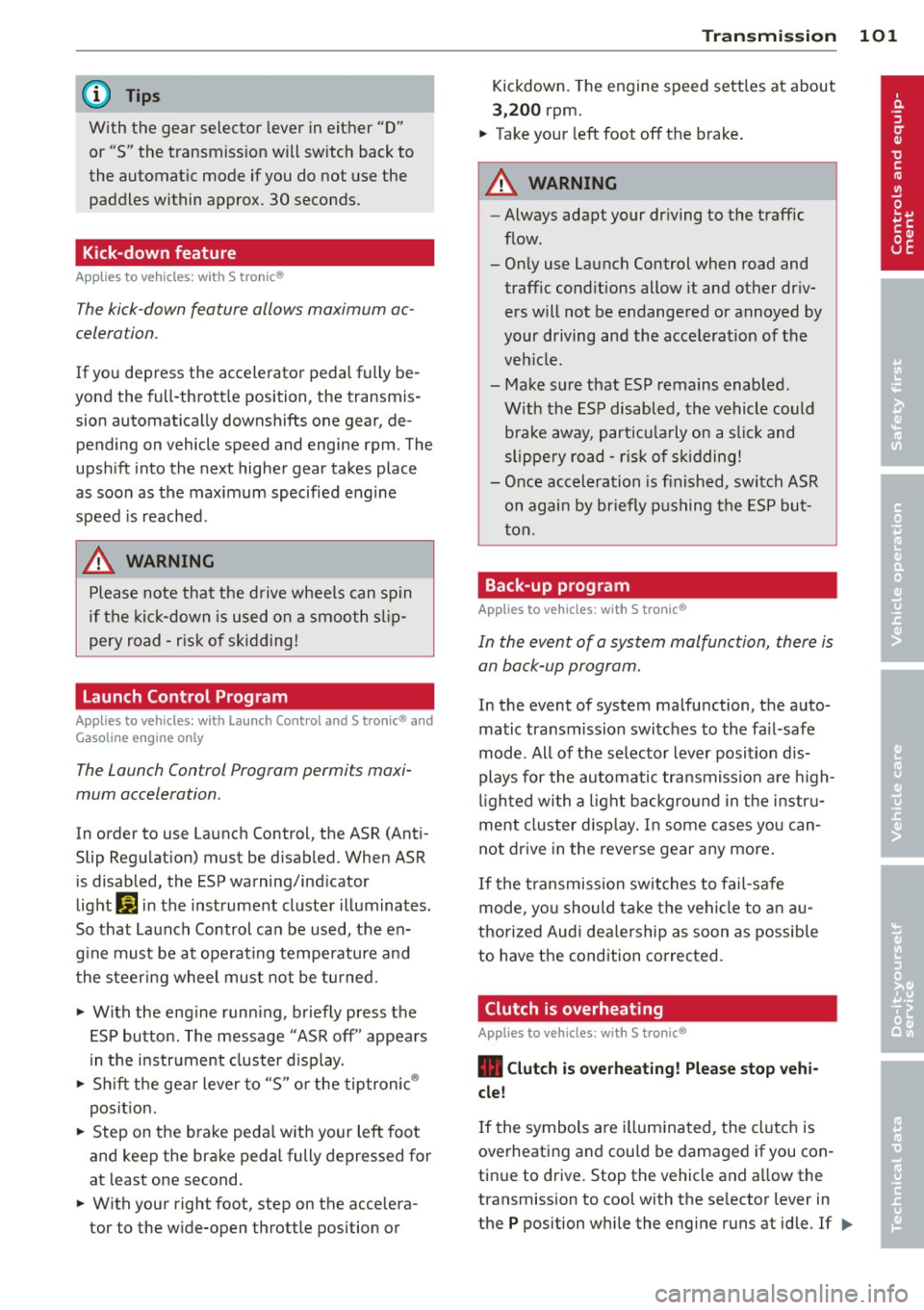
@ Tips
With the gear selector lever in either "D"
or "S" the transmiss ion will sw itch back to
the automatic mode if you do not use the paddles within approx. 30 seconds.
Kick-down feature
Applies to vehicles: with S tronic®
The kick-down feature allows maximum ac
celeration .
If you depress the accelerator pedal fully be
yond the full-thrott le position, the transmis
sion automatically downshifts one gear, de pending on vehicle speed and engine rpm. The
upsh ift into the next higher gear takes place
as soon as the max imum specified engine
speed is reached.
A WARNING
Please note that the drive wheels can spin
if the kick-down is used on a smooth s lip
pery road -ris k of skid ding!
Launch Control Program
Applies to vehicles: with Launch Control and S tronic® and
Gasoline engine only
The Launch Control Program permits maxi
mum acceleration .
In order to use launch Control, the ASR (Anti
Slip Regulation) must be disabled. When ASR is disabled, the ESP warning/ind icator
light
G1 in the instrument cluste r illuminates .
So that la unch Control ca n be used, the en
g ine must be at ope rating temperature a nd
the steer ing wheel mus t not be tu rned.
... With the eng ine run ning, briefly press the
ES P bu tton. The message "ASR off" appea rs
in the instrument cluster d isp lay.
... Sh ift th e gea r lever to "5" or the tip tronic ®
pos it ion.
... Step on t he b rake peda l w it h your left foot
and keep the brake peda l fully depressed for
at least one second.
... With your right foot, step on the accelera
tor to the w ide-open throttle position o r
Transm iss ion 10 1
Kickdown. The engine speed sett les at about
3 ,200 rpm.
... Take your left foot
off the b rake .
A WARNING
-Always adapt your dr iving to the traffic
f low.
- On ly use launch Control when road and
traffic cond itions allow it and other dr iv
ers will not be endangered or annoyed by
your driving and th e acce le rat ion of the
veh icle.
- Ma ke sure that ESP remains enab led.
W ith the ESP disabled, the vehicle could
brake away, part icu la rly on a s lick and
slippe ry r oad - ri sk of s kidding!
- Once acceleration is finished, switch ASR
on again by br iefly pushing t he ESP but
ton.
Back-up program
Applies to vehicles: with S tronic®
-
In the event of a system malfunction, there is
an back-up program.
In the event of system malfunction, the auto
matic transmission switches to the fa il-safe
mode . All of the selecto r lever posi tion d is
plays for the au toma tic tra nsmission a re high
li gh ted wi th a ligh t background in t he i nstr u
ment cluster d isp lay . In some cases yo u can
not drive in the reve rse gear any more .
If the t ransmission swit ches to fail-safe
mode, yo u should ta ke the ve hicl e to an a u
thorized Aud i dea le rship as soon as possib le
to have the condition corrected.
Clutch is overheating
Applies to vehicles: with S tronic®
• Clutch is overheating! Please stop vehi
cle!
If the symbols are i llum ina ted, the clutch is
ove rheati ng and could be dama ged if you con
tin ue to drive . Stop the vehicle and a llow the
transmission to cool with the se lector lever in
the
P position w hile the engine runs at idle . If Iii-
Page 104 of 280

102 Transmi ssion
the warning does not turn off, do not continue
driving . See your authorized Audi dealer or
qua lified repair fac ility for assistance. Other
wise serious transmission damage could re
sult. Once the indicator light has turned off,
drive to your authorized Audi dealer or quali
fied repair fac ility immediately to have t he
malfunction corrected.
Emergency release for selector lever
Appl ies to vehicles: with S tro nic®
If the vehicle's power supply fails, the selec
tor lever can be released in an emergency.
Fig. 115 Selector lever: Remove selector lever sleeve
Fig . 1 16 Selecto r lever : emerge ncy release from the
Park pos it io n
The emergency release mechanism is located
on the right front under the selector lever
shift gate. The release procedure requ ires pro
fess iona l dexterity . We recommend that you
seek assistance .
Removing the selector lever boot
.,. Engage the parking brake .
.,. Remove the screwdriver from the vehicle
tool kit . Use the flat side of the reversib le
screwdriver blade¢
page 234 .
.,. Carefully pry the cover out w ith the sc rew
dr ive r and pull it¢
fig. 115 towa rd the shift- er
knob in the direction of the arrow . The
screwdriver must grip at the lower edge of
the cover to loosen it .
Emergency rel ease for selector lev er
.,. Press t he ye llow release lever in the direc
tion of the arrow ¢
fig. 116 and hold it in
that position.
.,. Press t he re lease button in the selector lev-
er @ and move the lever into the N position.
.,. Clip the s hift boot back into the shift gate.
If the vehicle has to be pushed or towed if the
power supply fai ls (e.g. battery is discharged),
the selector lever must be moved to the N po
s ition using the emergency locking device.
A WARNING
-The selector must only be shifted from the
P position if the handbrake is firmly ap
p lied. Otherwise the vehi cle wou ld start
moving unexpe ctedly on a grade when the
se lec tor lever is s hifted from the P pos ition
- increasing the risk of an accide nt.
Page 163 of 280
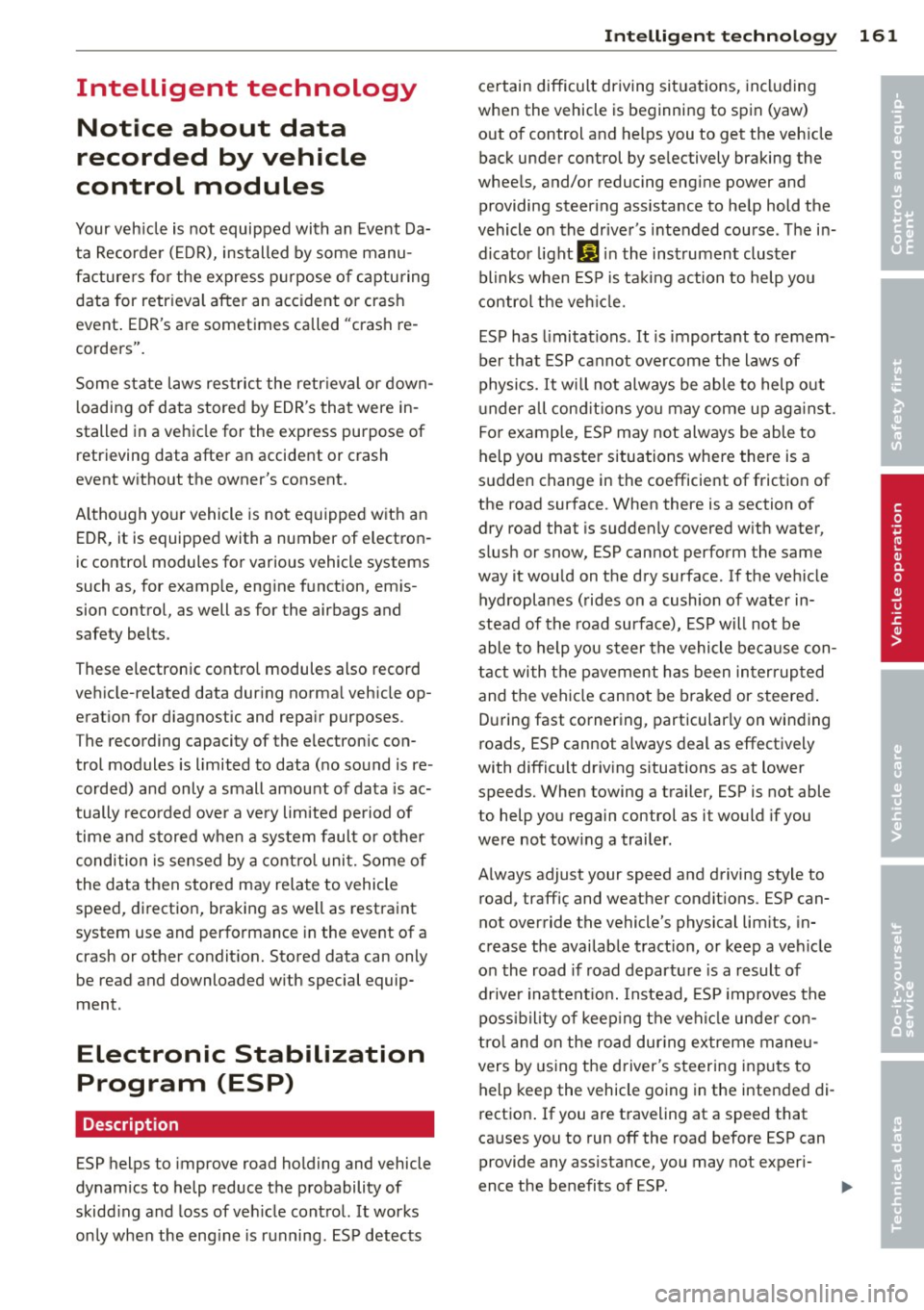
Intelligent technology Notice about data
recorded by vehicle
control modules
Your vehicle is not equipped with an Event Da
ta Recorder (EDR), installed by some manu
facturers for the express purpose of capturing
data for retrieval after an accident or crash
event. EDR's are sometimes called "crash re
corders".
Some state laws restrict the retr ieval or down
loading of data stored by EDR's that were in
stalled in a vehicle for the express purpose of
retrieving data after an accident or crash
event without the owner's consent.
Although your vehicle is not equipped with an
EDR, it is equipped with a number of electron
ic control modules for various vehicle systems
such as, for examp le, engine function, emis
sion control, as well as for the airbags and
safety belts.
These electronic control modules also record
vehicle-related data during norma l vehicle op
eration for diagnostic and repair purposes.
The recording capacity of the electronic con
trol modules is limited to data (no sound is re
corded) and only a small amount of data is ac
tually recorded over a very limited period of
time and stored when a system fault or other
condition is sensed by a control unit. Some of
the data then stored may relate to vehicle
speed, direction, braking as we ll as restraint
system use and performance in the event of a
crash or other condition. Stored data can only be read and downloaded with special equip
ment.
Electronic Stabilization
Program (ESP)
Description
ESP helps to improve road holding and vehicle
dynamics to help reduce the probability of
skidding and loss of veh icle control. It works
only when the engine is running. ESP detects
Intelligent technology 161
certain difficult driving situations, including
when the vehicle is beginning to spin (yaw)
out of control and helps you to get the veh icle
back under control by se lectively braking the
wheels, and/or reducing engine power and
providing steering ass istance to help hold the
vehicle on the driver's intended course. The in
dicator light
G] in the instrument cluster
blinks when ESP is taking action to help you
control the vehicle.
ESP has limitations. It is important to remem
ber that ESP cannot overcome the laws of
physics.
It will not always be able to help out
under all conditions you may come up against.
For example, ESP may not always be able to
help you master situations where there is a
sudden change in the coefficient of friction of
the road surface. When there is a section of dry road that is suddenly covered with water,
slush or snow, ESP cannot perform the same
way it would on the dry surface . If the vehicle
hydroplanes (rides on a cushion of water in
stead of the road surface), ESP will not be
able to help you steer the vehicle because con
tact with the pavement has been interrupted
and the vehicle cannot be braked or steered .
During fast cornering, particularly on winding
roads, ESP cannot always deal as effectively
with difficult driving situations as at lower
speeds. When towing a trailer, ESP is not able
to help you regain control as it would if you
were not tow ing a trailer.
A lways adjust your speed and driving style to
road, traffic; and weather conditions. ESP can
not override the vehicle's physical limits, in
crease the available traction, or keep a vehicle
on the road if road departure is a result of
driver inattention. Instead, ESP improves the
poss ibility of keeping the vehicle under con
trol and on the road dur ing extreme maneu
vers by using the driver's steering inputs to
help keep the vehicle going in the intended di
rection. If you are traveling at a speed that
causes you to run off the road before ESP can
provide any assistance, you may not experi
ence the benefits of ESP .
•
•
Page 164 of 280
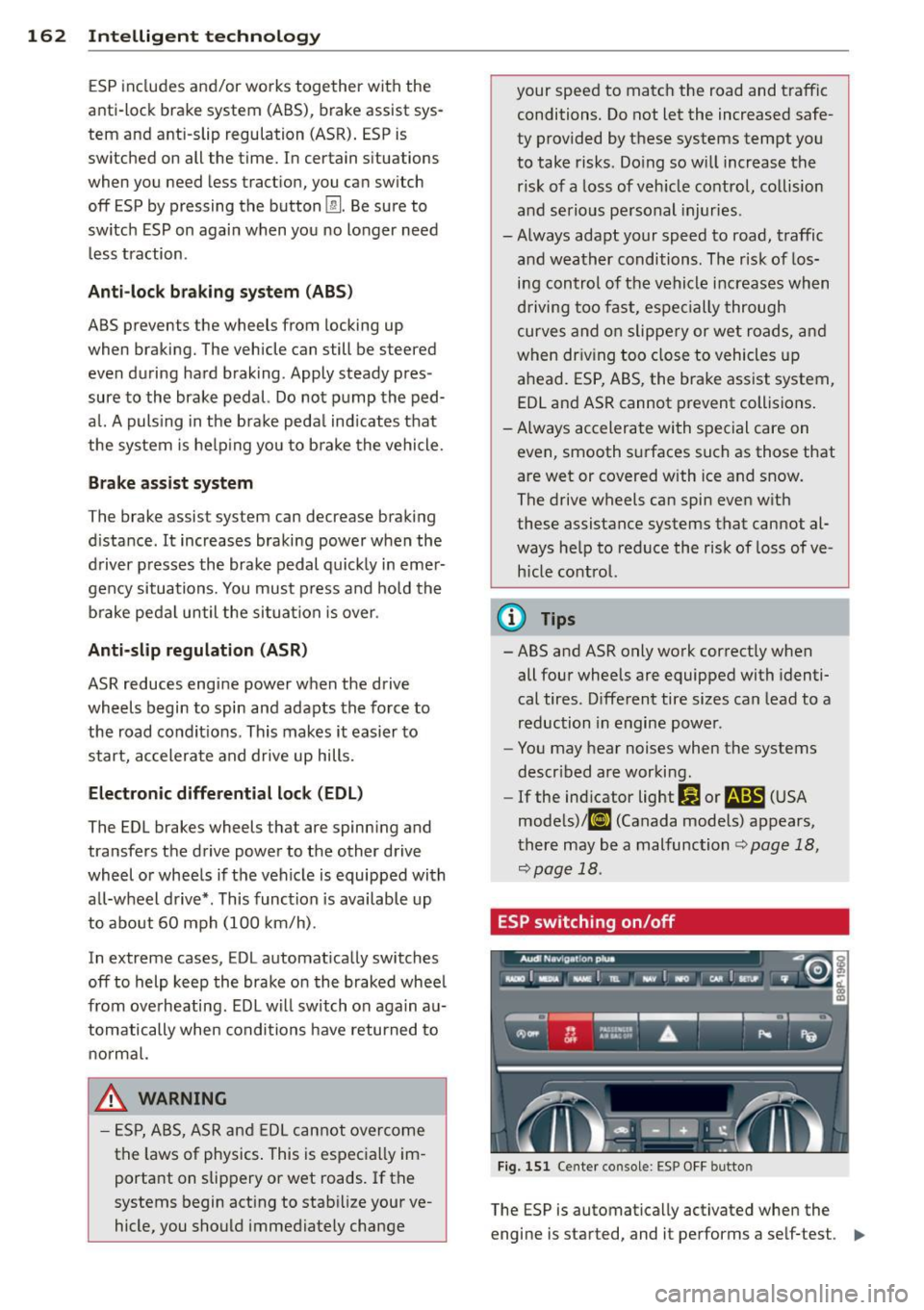
162 Intelligent technology
ESP includes and/or works together with the
anti-lock brake system (ABS), brake assist sys
tem and anti-slip regulation (ASR). ESP is
switched on all the time. In certain situations
when you need less tract ion, you ca n sw itch
off ESP by pressing the button [g] _ Be sure to
switch ESP on again when you no longer need l ess traction .
Anti-lock b raking system (ABS)
ABS prevents the wheels from locking up
when braking. The vehicle can still be steered
even during hard braking. Apply steady pres
sure to the brake pedal. Do not pump the ped
al. A puls ing in the b rake pedal ind icates that
the system is he lp ing you to b ra ke the vehicle.
Br ake a ssist system
The brake assist system can decrease braking
d istance. It increases braking power when the
d river presses the brake pedal quick ly in eme r
gency situations. You must press and hold the
brake peda l until the si tuation is over .
Anti-slip regulation (ASR)
ASR reduces engine power when the drive
wheels begin to spin and adapts the fo rce to
the road co ndit io ns. This makes it easier to
start, ac celerate and drive up hills.
Electronic differential loc k (EDL )
The EDL brakes wheels that are spinn ing and
transfers the drive power to the other drive
wheel or whee ls if the vehicle is equipped with
a ll-wheel d rive*. This funct ion is available up
to abo ut 60 mph (100 km/h).
In extreme cases, EDL automat ically switches
off to help keep the brake on the braked whee l
from ove rheating . EDL w il l switch on aga in au
tomatically when conditions have returned to
n o rmal.
& WARNING
- ESP, A BS, ASR an d EDL cannot ove rcome
the laws of physics . This is espec ially im
portant on slippery or wet roads. If the
systems begin act ing to stab ilize your ve
hicle, you should immediately cha nge your speed to matc
h the road and t raffic
conditions. Do not let the increased safe
ty provided by these systems tempt you
to take risks. Do ing so w ill increase the
ris k of a loss of veh icle control , co llision
and serious pe rsonal inj uries .
- Always adapt your speed to road, traffic and weather conditions. The risk of los
ing control of the vehicle inc reases when
d riving too fast, espec ially through
curves and on slippe ry or wet roads, and
when dr iv ing too close to vehicles up
ahead. ESP, ABS, the brake assist system, EDL an d ASR cannot prevent collisions.
- Always accelera te with special care on
even, smooth s urfaces such as those that
are wet or covered with ice and snow.
The drive wheels can spin even w ith
these assistance systems that cannot al
ways he lp to red uce the risk of loss of ve
h icle control.
(D Tips
- ABS and ASR only work correct ly when
all four wheels are equipped with identi
cal tires. Diffe rent tire sizes can lead to a
reduction in engine powe r.
- You may hear noises when the systems
descr ibed are working .
- If the indicator light
D] or m (USA
mode ls)/ KC] (Canada models) appears,
t here may be a malfunction~
page 18,
~page 18.
ESP switching on/off
Fig. 151 Ce nter conso le: ESP O FF butto n
The ESP is automat ically activated whe n the
engine is started, and it performs a se lf-test .
II>
Page 165 of 280

As soon as the test is completed, the system
is in normal operating mode.
Switching off
E SP should normally be activated at all times
because this ensures optimum vehicle stabil i
ty. In certa in situations, it might make sense
to a llow some slip . For example:
- Rocking the vehicle to free it when it is stuck
- Driving in deep snow or on loose ground
- Driving with snow cha ins
Press the
[!I button . The ESP indicator light I)
turns on and S tabil isat ion prog ram off ap
pears in the d isp lay. ASR deact ivates com
pletely and the stab ilizat ion effects from the
ESP system are lim ited.
S wi tc hing on
Press the [!I button again. The message S tab i·
li sa tion p rogram on
appears briefly in the dis
play.
A WARNING
You should only sw itch the ESP off if your
driving ability and the traffic s ituation per
m it. Please note that when ESP/ASR is de
act ivated, the drive whee ls can sp in on icy
and slippe ry roads and the vehi cle can
break away - danger of skidding!
(j) Tips
If A udi magnetic ride* is malfunctioning,
the ESP may not switch off or it may
sw itch off automatically.
Braking
General information
What affects braking efficiency?
Operating condit ions and d riving habit s
The brakes on today's automobi les are st ill
subject to wear, depending largely on operat
ing cond itions and dr iving habits
q .&. . On ve
hicles that are either driven mostly in stop
and -go city traffic or are driven hard, the
brake pads should be checked by your author-
Int ellig ent technolog y 163
ized Audi dea ler more often than specified in
the
W arra nty & M aintenance booklet. Failure
to have your brake pads inspected can result
in reduced brake performance.
On steep slopes, you sho uld use the b raking
effect of the engine. This way, you prevent un
necessary wear on the brake system. If you
must use your brakes, do not hold the brakes
down cont inuously. Pump the brakes at inter
vals.
Noises may occur when braking depending on
speed, braking force and outs ide cond it ions
such as temperature and humidity.
Mo isture o r road sal t
If you are driving faster than SO mph (80 km/
h) and the windshield wipers are on, the brake
pads will briefly touch the brake discs in regu
lar intervals so as to improve react ion time
when brak ing on wet surfaces. You, the driver,
will not not ice anything.
Under certain conditions, for example, when
driv ing through water or very heavy ra in, or
even after washing your veh icle, the braking
effect can be reduced due to moisture (or in
freez ing cond itions ice) on the brake pads. A
few cautious brake applications should dry off
the b ra ke pads or remove any ice coatings.
The effectiveness of the brakes ca n be reduced
when the vehicle is driven on a salt-cove red
road and the brakes are not used. l ikewise,
you clean off accumulated salt coating from brake d iscs and pads w ith a few cautio us ap
plications o f the b ra ke
¢ .&, .
Corrosion
T here may be a tendency for di rt to b uild up
o n the brake pads and corros ion to fo rm on
the d iscs if the car is not d riven regu larly or
o nly for short tr ips w ith litt le use of the
brakes.
If the brakes a re not used frequently, o r if cor
ros ion has formed on the discs, it is adv isable
to clean off t he pads and d iscs by braking
firmly a few times from a moderately high
speed ~.&. . .,.
•
•
Page 167 of 280

However, do not expect that the ABS shortens
braking distance under
all circumstances.
When driving on grave l or on newly fallen
snow on top of icy surfaces, braking distance may be even longer, therefore, under these
circumstances, it is especially important that
you dr ive slowly and with great care .
How th e ABS syste m work s
An automatic check is made when a speed of
about 4 mph (6 km/h) is reached. When this
happens, a pumping noise can be heard .
If an individua l wheel begins to rotate too
slowly in relation to vehicle speed and tends
to lock, the ABS automatically reduces brake
pressure to prevent that wheel from locking.
This automatic adjustment process will cause
a
s light vib ration of the brake pedal and some
noises to alert you that vehicle speed must be
adapted to existing road and traff ic condi
tions .
A WARNING
Although the ABS is very effective, always
remember that bra king capability is limit
ed by t ire traction. Always adjust your dr iv
ing speed according to the road and traffic
conditions . Do not let the extra sa fe ty af
forded bytheABStemptyou into taking
extra r isks. The ABS cannot overcome the
laws of physics.
(D Tips
- If ABS is not functioning properly, a
warning light will come on. See
¢ page 18.
- If a fault occurs in the ABS, the EDL is al
so not functioning . This is indicated by
the ABS warning light.
Brake assistant
The broke assistant is designed to achieve the
optimum broking effect .
The brake assistan t helps to increase the ef
fective
b raking power and thus to achieve a
shorter stopping distance . If the driver
Int ellig ent technolog y 165
presses the brake peda l very quick ly, the brake
assistant automatically boosts the braking
force to the max imum level, up to the po int
where the anti-lock brake function (ABS) inter
venes to stop the whee ls from locking. You
shou ld then keep the brake peda l pressed un
t il the vehicle has braked to the required
speed. The brake assistant switches itself off
as soon as you release the b ra ke peda l.
The brake ass istant wi ll not be operative if
there is a ma lfunction in the ABS.
A WARNING
P lease remember that the acc ident risk a l
ways increases if you drive too fast, espe
cially in corners or on a slippe ry road, o r if
you follow the vehicle ahead of yo u too
closely . An increased accident risk cannot
be compensated even by the brake assis
tant, so always mainta in a safe speed.
Electro-mechanical
power assist
The electro-mechanical power assist helps
the driver when steering .
The degree of power assist is electronically
matched to vehicle speed .
The power steering system assists the driver
so that he can steer the vehicle with reduced physical effort.
Power steering will not work if t he engine is
off . As a result, the steering wheel will be hard
to turn .
A WARNING
If the system deve lops a problem, you
must seek qualified professiona l assis
tance.
(D Note
If there is an e lectronic malfunction, ser
votronic
will still function like a conven-
tiona l power steering system, providing a
constant steering support force that is no
-
l onge r proportionate to the vehicle speed. ..,.
•
•